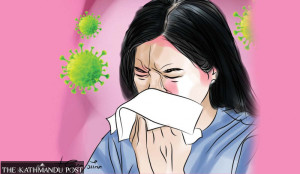Health
For many, the blistering cold of winter is literal
During peak winter, many Nepalis visit dermatologists to treat their swollen hands and feet resulting from cold sensitivity..jpg&w=900&height=601)
Srizu Bajracharya
Almost every winter, Mandira Shakya’s fingers swell, with red, purple and bluish patches and bumps on her hands. On severe cold exposure, her hands succumb to bruises and blisters. “They come and go, but each time my finger swell back, my hands feel heavy in a different way. They are more painful when I bang or knock my fingers accidentally,” says Shakya.
In her local vernacular Shakya terms the medical condition as ‘Puuchha’. But according to dermatologists, the condition is an inflammatory disorder called perniosis (also known as chilblains) and is triggered by prolonged exposure to cold weather conditions. “It happens mostly to people who are sensitive to cold weather. The disorder occurs when there is inflammation in small blood vessels due to cold sensitivity,” says Professor Bhaskar Mohan Kayastha, chief consultant dermatologist of Patan Hospital. And during winter, on a day to day basis, Kayastha estimates at least three patients visit the hospital seeking remedies.
According to doctors, perniosis is the most common wintertime medical condition and is more typical in young girls and women than in men. The hands and feet of people who get perniosis are usually cold even when exposed to warm temperatures. The sores appear mostly in the extremities, such as the fingers, toes, lower legs, feet, and, for some people, in sensitive areas like ears and face. The condition usually lasts for two to three weeks but may recur in freezing temperatures.
The medical condition is also likely to be a risk factor for those families who have a history of perniosis, say doctors. But it may also develop in people who have poor blood circulation, nutrition and those who are underweight. In Shakya’s family, the medical condition runs is felt by everyone. “I think the condition is hereditary. Every winter, my father, my two daughters and I complain to each other about our swollen hands and how it slows down our work,” says Shakya.
Although there are treatments, doctors say the condition is likely to return as the disorder is caused by people’s sensitivity to falling temperatures. For people like Shakya, perniosis has become part of her everyday life in winter. “I have learned to live with it,” she says. “We have tried everything, we have soaked our fingers and toes in warm, salty water, used hot water bags constantly, and have even tried massaging them; but it keeps returning,” she says.
According to medical studies, the prevention and treatment for the disease include wearing insulated warm clothes, soaking the lesion parts in warm water. Doctors also suggest avoiding cold and damp weather, especially in the morning and the evening. Kayastha proposes wearing double-layered gloves, thick socks, and keeping hands in pockets as the best solution.
But in severe cases, doctors also prescribe patients vasodilators and also recommend topical nitroglycerin ointment or steroid creams. And suggest visiting doctors in case the condition is severe and frequent every year. “Ordinary perniosis can be treated with home remedies, but if the chilblains are frequent, then it may also be indications to other diseases, and if neglected, can cause damage to internal organs,” says Kayastha. “Therefore, it is advisable that people who get perniosis continually during winter visit doctors for further examination,” adds Kayastha.
For some people, however, due to their lifestyle, working with water and exposure to cold weather can be unavoidable. “And for those we suggest them to use lukewarm water at all times and to wear warm thick clothes,” says Kayastha. But dry warmers like heat from the fire, electronic heaters and even the sun can spur a burning irritation in the lesion parts, say doctors. “It may retreat irritation. The itching is part of the skins’ reaction to warmth after the cold. But ordinary perniosis heals after a few weeks,” says Kayastha.
Perniosis, however, is not as critical as Raynaud’s disease, a medical condition which shows similar traits. “People who have Raynaud’s disease complain about intense pain, but this is a serious disorder than perniosis and needs more medical attention,” says Kayastha.
The disorder obstructs blood flow due to the spasm of arteries especially in fingers, feet and toes and is also connected to rheumatic diseases. There are, however, two types of the condition: primary Raynaud’s disease and secondary Raynaud’s disease which is also known as the Raynaud’s phenomenon. The later results through an underlying health condition, say doctors. Raynaud’s phenomenon can also be a symptom of lupus, rheumatoid arthritis and Sjogren’s syndrome.
But many people also confuse perniosis with morning stiffness, a medical condition that is tied with rheumatoid arthritis, an autoimmune disorder that affects various joints of the body. “They may at first seem alike, but these medical conditions are more severe than perniosis and need early medical consultation,” says Kayastha.
While Shakya’s fingers look bloated, her daughter Lunibha Shakya’s swelling shows a different character, they are red on the knuckles and have a spindle-like swelling. Her daughter describes the pain as heavy and stiff. “The pain feels like a sprain that you get when a basketball hits you on the fingers,” says Shakya. “Sometimes I am unable to bend my fingers, but as the days get warmer the pain subsides,” says Shakya.
Shakya’s mother suspects her daughter has rheumatoid arthritis (baath rog) from what she has heard about the disease from her relatives. “We still are yet to confirm it, but for now, like always we have just been keeping ourselves warm. I don’t let her leave the house without wearing gloves,” says Shakya.
“But our hands look better in the summer than winters,” says Shakya as she examines her red-bluish wobbly-swollen hands.




 15.12°C Kathmandu
15.12°C Kathmandu














